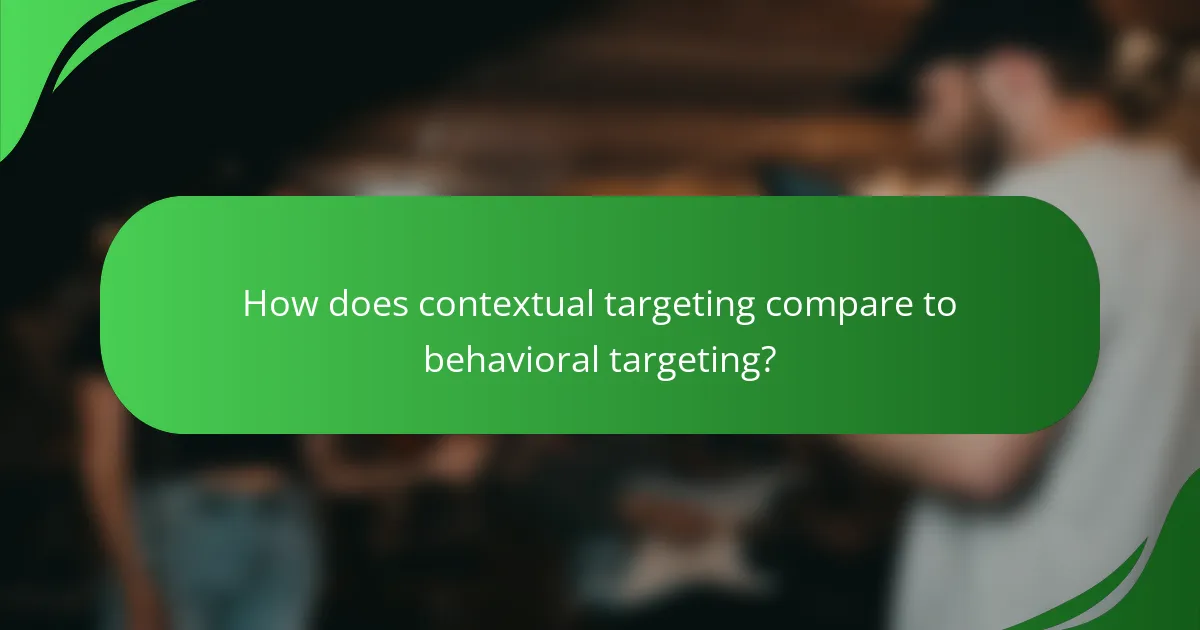Contextual targeting significantly boosts ad performance by delivering advertisements that are closely aligned with the content users are currently engaging with. This strategy not only enhances ad relevance but also increases user engagement, as it ensures that ads resonate with the audience’s interests and preferences. By focusing on relevant content, brands can effectively capture attention and drive action, leading to improved overall performance and user satisfaction.

How does contextual targeting improve ad performance in Australia?
Contextual targeting enhances ad performance in Australia by delivering ads that align closely with the content users are currently engaging with. This method increases the likelihood of capturing attention and driving action, as ads are shown in relevant contexts that resonate with the audience’s interests.
Increased engagement rates
Contextual targeting leads to higher engagement rates by presenting ads in environments that match user intent. When users encounter ads that relate directly to the content they are consuming, they are more likely to interact with those ads, resulting in increased click-through rates.
For example, a user reading an article about travel may respond better to ads for vacation packages than to unrelated products. This alignment fosters a more engaging experience, encouraging users to explore the advertised offerings.
Higher relevance for audiences
By focusing on the context of the content, contextual targeting ensures that ads are more relevant to the audience. This relevance is crucial in capturing the attention of users who are already interested in similar topics, making the ads feel less intrusive and more like a natural extension of their browsing experience.
In Australia, advertisers can leverage local trends and interests, tailoring their campaigns to resonate with specific demographics or regions. This localized approach enhances the perceived value of the ads, leading to better audience reception.
Improved conversion rates
Improved relevance through contextual targeting often translates to higher conversion rates. When users see ads that are pertinent to their current interests, they are more inclined to take action, whether that means making a purchase or signing up for a newsletter.
To maximize conversion rates, advertisers should continuously analyze performance data and adjust their targeting strategies based on what resonates most with their audience. Utilizing A/B testing can help identify the most effective ad placements and messaging, ensuring that campaigns remain optimized for success.

What are the key benefits of contextual targeting?
Contextual targeting offers several advantages, primarily enhancing ad relevance and user engagement. By aligning advertisements with the content being consumed, brands can improve performance and user satisfaction.
Enhanced user experience
Contextual targeting significantly improves the user experience by delivering ads that are relevant to the current content. When users see ads that relate to their interests or the topics they are engaging with, they are more likely to find the ads useful rather than intrusive.
This relevance can lead to increased interaction rates, as users are more inclined to click on ads that resonate with their current activities. For example, a user reading an article about travel may appreciate seeing ads for vacation packages or travel gear.
Reduced ad fatigue
By focusing on the context rather than user behavior alone, contextual targeting helps reduce ad fatigue. Users often become desensitized to repetitive ads based on their browsing history, leading to a decline in engagement over time.
Contextual targeting refreshes the ad experience by introducing new and relevant ads based on the content being viewed. This approach can keep the advertising experience dynamic and engaging, preventing users from becoming bored or annoyed with the same ads.
Better alignment with content
Contextual targeting ensures that ads are better aligned with the content, which enhances the overall effectiveness of the advertising strategy. When ads are placed alongside relevant content, they are more likely to capture the audience’s attention and drive conversions.
For instance, an ad for a cooking appliance displayed on a food blog is likely to perform better than the same ad on an unrelated site. This alignment not only boosts ad performance but also reinforces the brand’s message by contextualizing it within the user’s current interests.

How to implement contextual targeting effectively?
To implement contextual targeting effectively, focus on aligning your ads with relevant content to enhance engagement and relevance. This approach increases ad performance by ensuring that the right audience sees your ads in the right context.
Utilize data analytics tools
Data analytics tools are essential for understanding user behavior and content performance. By analyzing metrics such as page views, bounce rates, and time spent on pages, you can identify which types of content resonate with your audience.
Consider using tools like Google Analytics or Adobe Analytics to gather insights. These platforms can help you track user interactions and refine your targeting strategies based on real-time data.
Leverage AI-driven platforms
AI-driven platforms can automate and optimize your contextual targeting efforts. These systems analyze vast amounts of data to determine the best placements for your ads, enhancing relevance and engagement.
Utilizing services like Google Ads or Facebook Ads can streamline this process. They offer machine learning capabilities that adapt to user preferences, improving ad performance over time.
Segment audiences by interests
Segmenting your audience by interests allows for more tailored ad experiences. By categorizing users based on their preferences, you can deliver content that is more likely to engage them.
Use demographic data, browsing history, and engagement metrics to create specific audience segments. For example, targeting tech enthusiasts with ads related to the latest gadgets can significantly boost engagement rates.

What are the challenges of contextual targeting?
Contextual targeting faces several challenges that can impact its effectiveness, including data privacy concerns, ad placement limitations, and content misalignment risks. These issues can hinder the ability to deliver relevant ads to the right audience at the right time.
Data privacy concerns
Data privacy is a significant challenge in contextual targeting, as regulations like GDPR and CCPA impose strict guidelines on data collection and usage. Advertisers must ensure compliance while still aiming to deliver personalized ad experiences.
To navigate these concerns, companies should focus on using first-party data and contextual signals rather than relying on extensive user tracking. This approach can help maintain user trust while still achieving relevant targeting.
Ad placement limitations
Ad placement limitations arise from the necessity to display ads only on content that aligns with the target audience’s interests. This can restrict the available inventory, making it challenging to reach broader audiences.
Advertisers should consider diversifying their placements across various platforms and content types to mitigate this limitation. Testing different contexts can help identify where ads perform best without compromising relevance.
Content misalignment risks
Content misalignment risks occur when ads appear alongside content that does not resonate with the intended message or brand values. This can lead to negative perceptions and reduced ad effectiveness.
To minimize these risks, advertisers should implement robust content filtering mechanisms. Regularly reviewing and adjusting placement criteria based on performance data can also help ensure that ads align with suitable content.

How does contextual targeting compare to behavioral targeting?
Contextual targeting focuses on the content surrounding an ad, while behavioral targeting relies on user data and past behaviors. This distinction affects engagement, relevance, and overall ad performance, making each approach suitable for different marketing objectives.
Focus on content relevance
Contextual targeting emphasizes the relevance of the content where ads appear. By analyzing the context of web pages, advertisers can place ads that align with the current topic, increasing the likelihood of user engagement. For example, an ad for hiking gear on an outdoor adventure blog is more relevant than the same ad on a cooking site.
This relevance can lead to higher click-through rates, as users are more likely to engage with ads that resonate with their immediate interests. Advertisers should consider the themes and keywords of the content to optimize their contextual strategies.
Less reliance on user data
Unlike behavioral targeting, which depends heavily on user data such as browsing history and demographics, contextual targeting requires minimal personal information. This approach can be beneficial in regions with strict data privacy regulations, as it reduces the risk of non-compliance with laws like GDPR in Europe.
By focusing on the content rather than user profiles, advertisers can still reach their target audience effectively while respecting privacy concerns. This method can also appeal to users who prefer not to have their data tracked.
Different targeting strategies
Contextual targeting employs strategies based on the analysis of page content, keywords, and themes, while behavioral targeting uses algorithms to track user behavior across platforms. Advertisers using contextual targeting might utilize keyword targeting, topic targeting, or even sentiment analysis to determine the best ad placements.
On the other hand, behavioral targeting often involves retargeting ads based on previous interactions, which can lead to higher conversion rates for users who have shown interest. Marketers should choose their strategy based on campaign goals, audience preferences, and compliance with data regulations.

What tools are available for contextual targeting?
Contextual targeting utilizes various tools to enhance ad relevance and engagement by placing ads based on the content of the surrounding environment. These tools can analyze webpage content, user behavior, and even contextual signals to optimize ad placements effectively.
Content Analysis Tools
Content analysis tools assess the text, images, and overall theme of a webpage to determine its context. They utilize natural language processing (NLP) and machine learning algorithms to categorize content accurately. Popular tools include Google Cloud Natural Language and IBM Watson, which help advertisers match their ads to relevant content.
Keyword Targeting Solutions
Keyword targeting solutions focus on specific words or phrases within content to serve ads that align with user interests. Advertisers can use platforms like Google Ads to select keywords that reflect their products or services. This method allows for precise targeting, ensuring that ads appear on pages with relevant discussions.
Audience Segmentation Tools
Audience segmentation tools help identify and categorize users based on their behavior and preferences. By analyzing data from previous interactions, these tools can tailor ad placements to specific audience segments. Platforms like Facebook Ads and Google Ads offer robust audience segmentation features to enhance contextual targeting efforts.
Ad Placement Platforms
Ad placement platforms facilitate the actual display of ads in contextually relevant environments. These platforms, such as Taboola and Outbrain, leverage algorithms to determine the best sites for ad placements based on content analysis and user engagement metrics. This ensures that ads reach the right audience at the right time.
Performance Analytics Tools
Performance analytics tools track the effectiveness of contextual targeting campaigns by measuring engagement metrics such as click-through rates and conversions. Tools like Google Analytics provide insights into how well ads perform in different contexts, allowing advertisers to refine their strategies for better results. Regular analysis helps in optimizing future campaigns.



